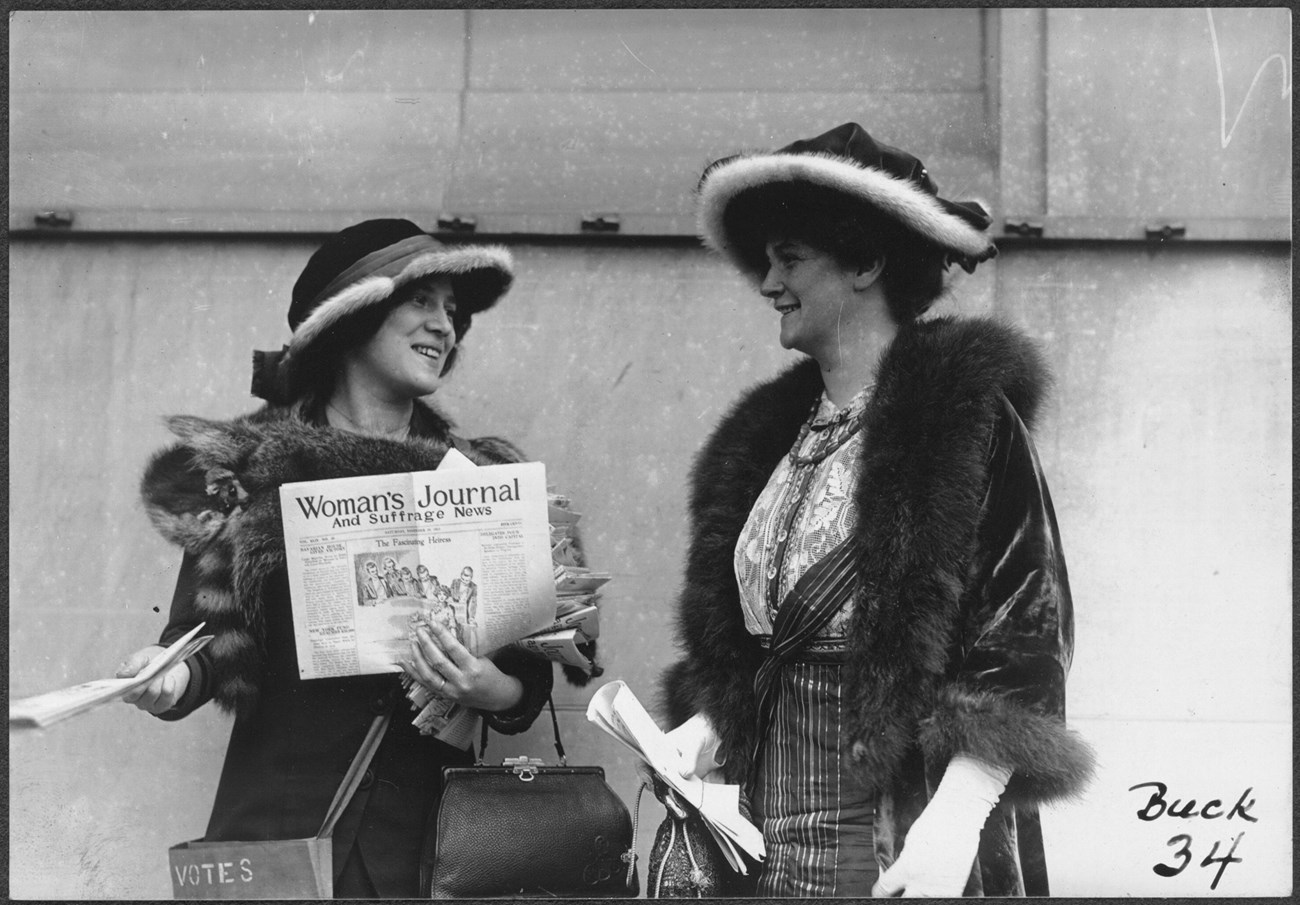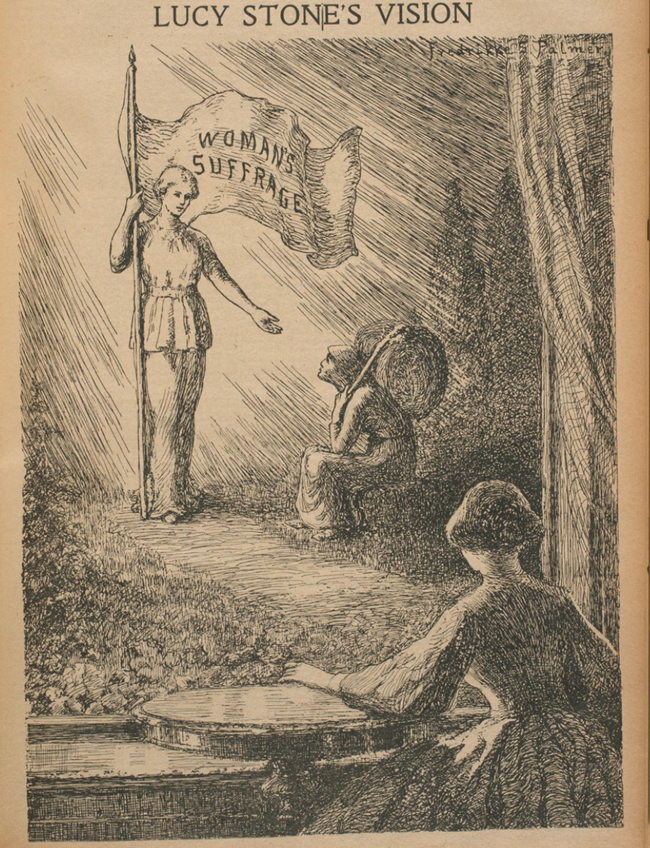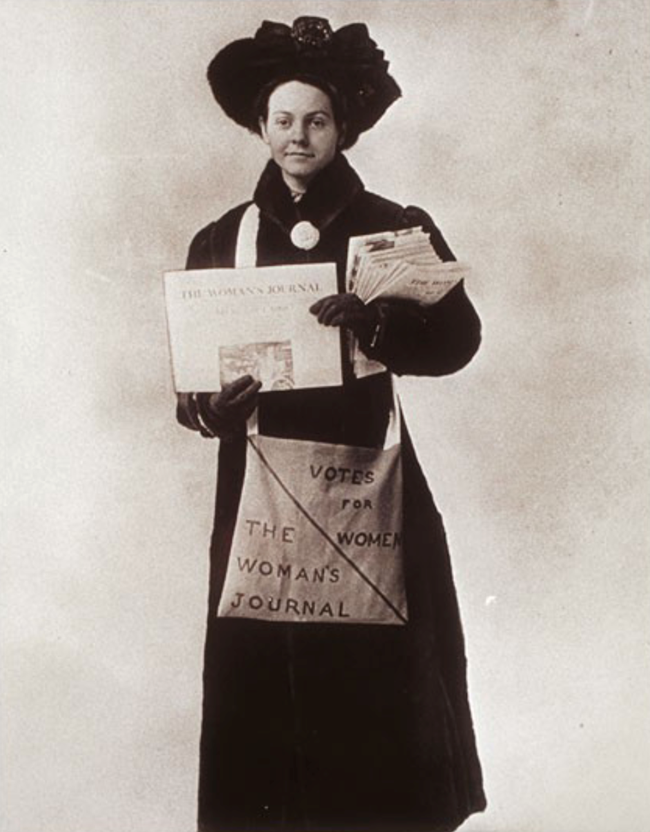Last updated: January 16, 2025
Article
"The Woman's Journal"

ca. 1913, retrieved from Library of Congress
First published in 1870, The Woman’s Journal served as the voice of the US women’s suffrage movement for almost 50 years. It covered suffrage work as well as highlighted other news and achievements by women. This "Suffrage Bible" spread its message across the United States and the world, reaching a readership no other suffrage nor women’s rights publication could match at the time.[1]

Woman's Journal, August 13, 1915.
Beginnings
Boston suffragist Lucy Stone founded the Woman's Journal alongside her husband Henry Blackwell. In the first issue published on January 8, 1870, the Journal announced itself as:
A Weekly Newspaper, published every Saturday, in Boston and Chicago, devoted to the interests of Woman, to her educational, industrial, legal and political Equality, and especially to her rights of Suffrage.[2]
Although not officially connected to any suffrage organization, the weekly publication aligned with the American Woman Suffrage Association (AWSA). Stone and her allies established this suffrage organization after they split with Susan B. Anthony and Elizabeth Cady Stanton.[3] Chicago women’s rights activist Mary Livermore served as the Journal’s first editor-in-chief until 1872, at which point Stone and Blackwell took over editorial duties. Other early writers and editors included Julia Ward Howe, Thomas Higginson, and William Lloyd Garrison. Howe and Higginson also supported the paper as early stakeholders alongside more than 50 others from the New England area. These stakeholders included local abolitionists and women’s rights activists, most notably Sarah Grimke and Angelina Grimké Weld.[4]
Topics Covered
The Woman’s Journal covered local and national suffrage activity. Due to its Boston location, the publication printed many articles related to local conventions and events. In December 1873, the Journal devoted numerous pages to the speeches of the New England Woman’s Tea Party. The Journal also tracked national progress by covering events happening throughout the states.
In addition to suffrage news, the Journal published political tracts, current events, editorials, letters from supporters, as well as short stories and poetry. Although focused on women’s suffrage, the Journal debated other women’s rights issues and celebrated women’s accomplishments around the world.
Some historians consider the tone of the Woman’s Journal as more moderate compared to other women’s rights papers. Professor Allison Lange calls the publication the "voice for more measured activists," noting its focus on purely legal and political rights for women.[5] Historian Barbara Berenson notes that the Journal "adopted a positive outlook; throughout the long suffrage struggle, it would stress progress and maintain that success was inevitable."[6] While maybe not as radical as other publications, its tone and material likely influenced the publication’s wide appeal.
Expansion
In 1881, Alice Stone Blackwell (daughter to Lucy Stone and Henry Blackwell) became an editor of the Woman’s Journal. Together, the Stone-Blackwell family continued to nurture the paper’s growth into the late 1800s. Lucy Stone, Henry Blackwell, and Alice Stone Blackwell dedicated both time and financial resources to the publication while also seeking to expand its influence. They encouraged other newspapers to print its articles, enticed more subscribers and financial backers, and expanded its reach by printing over 30 political leaflets under its name.[7] When Lucy Stone died in 1893 and Henry Blackwell in 1909, Alice Stone Blackwell took over leadership of the paper.
For the Woman’s Journal, the 1910s saw significant growth in a short amount of time. From 1910-1912, the National American Woman Suffrage Association (NAWSA), temporarily funded the paper and made it the national organization’s official "organ" during this time. In October 1912, the Woman’s Journal changed its name to the Woman’s Journal and Suffrage News.[8]
Thanks to its growing readership, the Journal’s coverage of national and international news grew. Large sections of the paper documented work in various states and countries. Subscribers across 48 US states (in addition to D.C. and Alaska), as well as 39 countries, received the Woman’s Journal.[9] At the height of circulation in 1915, the Journal published more than 27,000 copies each week.[10]
Due to this wide coverage, the Woman’s Journal became an even more essential mouthpiece of the movement. National leader Carrie Chapman Catt described its importance:
The Woman’s Journal has always been the organ of the suffrage movement, and no suffragist, private or official, can be well informed unless she is a constant reader of it. It is impossible to imagine the suffrage movement without the Woman’s Journal.[11]

Schlesinger Library, Radcliffe Institute, Harvard University
During this time, the operations of the publication became a much larger undertaking. In 1910, the Journal employed one full-time worker and one part-time worker in addition to Alice Stone Blackwell. In 1916, the Woman’s Journal had several departments and a full-time staff of 24 people. Several editors, including Agnes E. Ryan, joined the Journal to assist Blackwell with running the publication.[12] Other staff oversaw printing and circulation; tracked subscriber lists and funding sources; and answered general inquiries sent to the Boston office. The publication also employed artists, including female illustrators Fredrikke S. Palmer, Lou Rogers, and Blanche Ames. Their suffrage and political cartoons often landed in the Woman’s Journal.[13]
Along with the national and international expansion, the Journal also expanded its local readership. Local suffrage organizations had copies in their offices available for purchase. When local suffragists took to the streets, they brought the Woman’s Journal with them. Florence Luscomb stood on street corners as a "Hawker and Peddler," selling copies on Saturday afternoons.[14] Margaret Foley sold copies at the end of public suffrage events and meetings. Foley often said at these events:
The best way to get authentic information and news about Votes for Women is to read the organ of the suffrage movement, the Woman’s Journal and Suffrage News.[15]
The exponential growth of the Woman’s Journal in the 1910s inevitably led to more expenses. Although receiving some financial help from stakeholders, including the wealthy Bostonian Pauline Agassiz Shaw, Alice Stone Blackwell struggled to raise enough money to support the Journal.[16] She often had to contribute a significant amount from her personal savings to keep it running. Trying to raise more funds, Agnes E. Ryan wrote and published a short booklet about the Journal called The Torch Bearer. In this booklet, Ryan shared the financial burdens of the national paper, encouraging readers to contribute financial support.[17]
Changing Ownership and Legacy
Despite efforts to continue publication, the Woman’s Journal could not continue without stronger financial backing. Sometime in 1917, Carrie Chapman Catt used funds from a donor to purchase the longtime publication. She moved its location from Boston to New York City, renamed it The Woman Citizen, and made it the official organ of NAWSA. Although no longer leading the publication, Alice Stone Blackwell remained a contributing editor.[18]
In the first edition of the Woman Citizen, Catt gave credit to the work of Blackwell and her family for nurturing the Journal. She recognized it as a "history maker and history recorder...The suffrage success of today is not conceivable without the Woman’s Journal part in it."[19]
For decades, the Woman’s Journal brought the topics of the women’s suffrage movement to communities and peoples’ homes in Boston, across the country, and around the world. Agnes Ryan explained that it served as “the connecting link between the individual suffragist and the movement itself.”[20] Through the work of the Stone-Blackwell family and countless writers, editors, staff, and volunteers, The Woman’s Journal provided suffragists with the information and messaging they needed to advance the cause.
Footnotes
[1] Agnes E. Ryan, The Torch Bearer: A Look Forward and Back at the Woman's Journal, the Organ of the Woman's Movement (Boston, MA: The Woman's Journal and Suffrage News, 1916), 11.
[2]"The Woman’s Journal," The Woman’s Journal, January 8, 1870, Schlesinger Library, Radcliffe Institute, Harvard University, https://iiif.lib.harvard.edu/manifests/view/drs:48852545$5i.
[3] The two factions split primarily over the 15th Amendment. Lucy Stone and others (mostly in New England) supported the 15th amendment to achieve voting rights for Black men, believing progress for some is progress for all, whereas Stanton, Anthony, and their allies vowed not to support the 15th Amendment unless women were included. Read more...
[4] Ryan, The Torch Bearer, 53-54.
[5] Allison K. Lange, Picturing Political Power: Images in the Women's Suffrage Movement (Chicago: University of Chicago Press, 2020), 73-74.
[6] Barbara Berenson, Massachusetts in the Woman Suffrage Movement (Charleston, South Carolina: The History Press, 2018), 53.
[7] Berenson, Massachusetts in the Woman Suffrage Movement, 65-67; Ryan The Torch Bearer, 16.
[8] "Woman's Journal and Woman's Journal and Suffrage News," Harvard ListView, accessed March 2023, https://listview.lib.harvard.edu/lists/hollis-002490378.
[9] Ryan, 34-35.
[10] Ryan, 23.
[11] Ryan, 15.
[12] Ryan, 46-48.
[13] Ryan, 31.
[14] Papers of Florence Luscomb, Series III: Social and Political Activism, MC 39, 212: Suffrage Writings by FHL, including reminiscences, Schlesinger Library, Radcliffe Institute, Harvard University.
[15] Ryan, 50.
[16] Many other suffragists and activists supported the publication as stakeholders. In 1916, stakeholders included Jane Addams, Emma Blackwell, Maud Wood Park, Florence Luscomb, and Judith Winsor Smith. For a full list of 1916 stakeholders, see The Torch Bearers, 54-55.
[17] See Ryan, The Torch Bearer.
[18] Berenson, 149.
[19] As quoted in Berenson, 149. Original source "The Woman Citizen," The Woman Citizen (formerly Woman's Journal), June 2, 1917.
[20] Ryan, 34.
